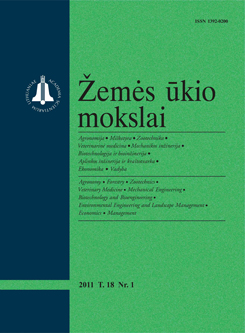 ISSN 1392-0200 |
2008 m. Nr. 3 Agrochemical properties of Lithuanian soils and their changes after regaining independence
Since 1992, when the volume of liming in the country has greatly decreased and since 1997 the liming of fields has practically ceased, soil acidification has been in progress. Comparing the data of 1995–2006 and 1985–1993, the area of conditionally acid (pH 5.5 and <) soils in the country has increased on an average by 2.1%. The most intensive acidification is observed in previously strongly and moderately acid soils of West Lithuania where it increased by 8.7%, while in Plungė, Tauragė and Šilalė districts by 12.3–29.9%. Acidification of soils in East Lithuania, as compared to West Lithuania, is less. At present, the decreasing pH is far less harmful to plants as they contain a still unrecovered content of exchangeable Al. Besides, the content of exchangeable cations is still relatively high at a depth of 1 m. In the soils of Šilalė, Tauragė, Kretinga, Klaipėda districts (pH 4.6–5.0), the content of exchangeable aluminium (Al) after intensive liming comprised only 0.42–1.76 mekv kg–1, while that of exchangeable cations (Ca, Mg) in the humus layer (pH 4.1–5.0) comprised 30.8–42.0 mekv kg–1. According to data of 1995–2006, 11.2% of Lithuanian soils have a very low, 33.4% low, 26.6% moderate, 13.7% a bit too high and 15.1% a high or very high content of available phosphorus. Most available P2O5 is found in soils of Central Lithuania where the average P2O5 content comprises 138.1 mg kg–1. A considerably lower content of available P2O5 is found in West Lithuania (average 99.4 mg kg–1). Its changes are insignificant. The content of available phosphorus in East Lithuanian soils, as compared to Central Lithuania, is lower (117.4 mg kg–1). Lithuanian soils contain more of available K2O than of available P2O5. Soils with a very low content of potassium comprise 2.1%, low 14.7%, moderate 38.6%, high 26.3%, high and very high 18.3%, while soils with a sufficient content of K2O (> 150 mg kg–1) comprise 44.6%. The content of available P2O5 and K2O and their balance in the soil were mostly dependent on the rate of phosphorus (R = 0.95) and potassium (R = 0.92) fertilizers and their ratio with nitrogen. Obtaining average yields of agricultural crops and seeking to ensure positive changes in the content of available P2O5 and K2O, agricultural crops should be fertilized applying 40–60 kg ha–1 P2O5 and 90–120 kg ha–1 K2O rates. Keywords: soils, fertilizers, pH, exchangeable cations, available P2O5 and K2O |
Numeriai:
2012 - T.19 Nr.1 2011 - T.18 Nr.1, Nr.2, Nr.3, Nr.4 2010 - T.17 Nr.1-2, Nr.3-4 2009 - T.16 Nr.1-2, Nr.3-4 2008 - T.15 Nr.1, Nr.2, Nr.3, Nr.4 2007 - T.14 Nr.1, Nr.2, Nr.3, Nr.4, Nr.Priedas 2006 Nr.1, Nr.1.Priedas, Nr.2, Nr.3, Nr.4 2005 Nr.1, Nr.2, Nr.3, Nr.4 2004 Nr.1, Nr.2, Nr.3, Nr.4 2003 Nr.1, Nr.2, Nr.3, Nr.4 2002 Nr.1, Nr.2, Nr.3, Nr.4 2001 Nr.1, Nr.2, Nr.3, Nr.4 |